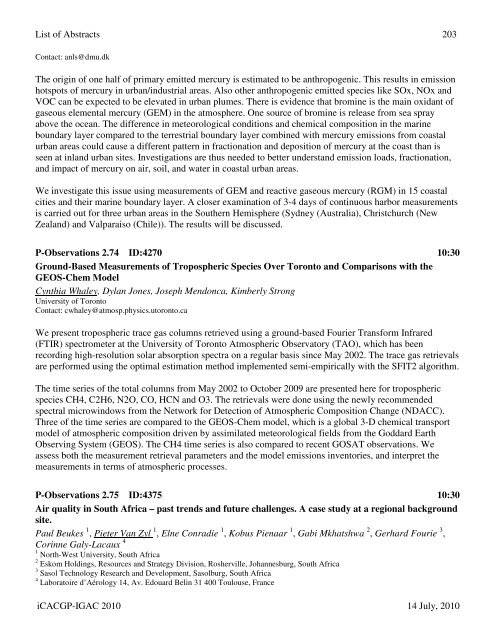Download Abstracts Here - IGAC Project
Download Abstracts Here - IGAC Project
Download Abstracts Here - IGAC Project
You also want an ePaper? Increase the reach of your titles
YUMPU automatically turns print PDFs into web optimized ePapers that Google loves.
List of <strong>Abstracts</strong> 203Contact: anls@dmu.dkThe origin of one half of primary emitted mercury is estimated to be anthropogenic. This results in emissionhotspots of mercury in urban/industrial areas. Also other anthropogenic emitted species like SOx, NOx andVOC can be expected to be elevated in urban plumes. There is evidence that bromine is the main oxidant ofgaseous elemental mercury (GEM) in the atmosphere. One source of bromine is release from sea sprayabove the ocean. The difference in meteorological conditions and chemical composition in the marineboundary layer compared to the terrestrial boundary layer combined with mercury emissions from coastalurban areas could cause a different pattern in fractionation and deposition of mercury at the coast than isseen at inland urban sites. Investigations are thus needed to better understand emission loads, fractionation,and impact of mercury on air, soil, and water in coastal urban areas.We investigate this issue using measurements of GEM and reactive gaseous mercury (RGM) in 15 coastalcities and their marine boundary layer. A closer examination of 3-4 days of continuous harbor measurementsis carried out for three urban areas in the Southern Hemisphere (Sydney (Australia), Christchurch (NewZealand) and Valparaiso (Chile)). The results will be discussed.P-Observations 2.74 ID:4270 10:30Ground-Based Measurements of Tropospheric Species Over Toronto and Comparisons with theGEOS-Chem ModelCynthia Whaley, Dylan Jones, Joseph Mendonca, Kimberly StrongUniversity of TorontoContact: cwhaley@atmosp.physics.utoronto.caWe present tropospheric trace gas columns retrieved using a ground-based Fourier Transform Infrared(FTIR) spectrometer at the University of Toronto Atmospheric Observatory (TAO), which has beenrecording high-resolution solar absorption spectra on a regular basis since May 2002. The trace gas retrievalsare performed using the optimal estimation method implemented semi-empirically with the SFIT2 algorithm.The time series of the total columns from May 2002 to October 2009 are presented here for troposphericspecies CH4, C2H6, N2O, CO, HCN and O3. The retrievals were done using the newly recommendedspectral microwindows from the Network for Detection of Atmospheric Composition Change (NDACC).Three of the time series are compared to the GEOS-Chem model, which is a global 3-D chemical transportmodel of atmospheric composition driven by assimilated meteorological fields from the Goddard EarthObserving System (GEOS). The CH4 time series is also compared to recent GOSAT observations. Weassess both the measurement retrieval parameters and the model emissions inventories, and interpret themeasurements in terms of atmospheric processes.P-Observations 2.75 ID:4375 10:30Air quality in South Africa – past trends and future challenges. A case study at a regional backgroundsite.Paul Beukes 1 , Pieter Van Zyl 1 , Elne Conradie 1 , Kobus Pienaar 1 , Gabi Mkhatshwa 2 , Gerhard Fourie 3 ,Corinne Galy-Lacaux 41 North-West University, South Africa2 Eskom Holdings, Resources and Strategy Division, Rosherville, Johannesburg, South Africa3 Sasol Technology Research and Development, Sasolburg, South Africa4 Laboratoire d’Aérology 14, Av. Edouard Belin 31 400 Toulouse, FranceiCACGP-<strong>IGAC</strong> 2010 14 July, 2010








